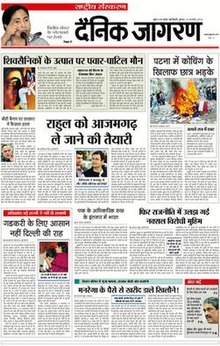Dainik Jagran
 Front page, 28 March 2010 | |
| Type | Daily newspaper |
|---|---|
| Format | Broadsheet |
| Owner(s) | Jagran Prakashan Limited |
| Founded | 1942[1] |
| Language | Hindi |
| Headquarters | Jagran Building, 2, Sarvodya Nagar, Kanpur-208 005, Uttar Pradesh, India |
| Country | India |
| Circulation | 34 lakh (3.4 million) daily[2] (as of July–December 2018) |
| OCLC number | 416871022 |
| Website | jagran.com |
| |
Dainik Jagran (lit. transl. daily awakening) is an Indian Hindi language daily newspaper.[3] It is ranked 5th in the world and 2nd in India by circulation.[4] In 2019 Quarter 4, according to Indian Readership Survey, Dainik Jagran reported a total readership of 6.86 crore (68.6 million) and was the top publication.[5] It is owned by Jagran Prakashan Limited,[6] a publishing house listed on the Bombay Stock Exchange and the National Stock Exchange of India.
History[]
Dainik Jagran was founded during British Raj and India's struggle for freedom. The newspaper was launched in 1942 by Puran Chandra Gupta, JC Arya, and Gurudev and later edited by Narendra Mohan.[1][additional citation(s) needed] The first edition of the newspaper was published in Jhansi and the Kanpur edition came 5 years later in 1947. Subsequently, the Rewa and Bhopal edition were launched in 1953 and 1956 respectively. In 2003, several other city editions were added. The cities included Ranchi, Jamshedpur, Dhanbad, Panipat and Bhagalpur. In 2004, Haldwani and Ludhiana Editions were also launched. Muzaffarpur, Jammu and Dharamshala editions came in 2005.[7]
Acquisitions[]

Jagran Prakashan Limited also acquired Mid-Day in 2010[8] and Naiduniya in 2012.[9]
Criticism[]
Dainik Jagran observed silence over Delhi violence and was accused of suppressing the incident.[10]
Dainik Jagran is also accused of running false narratives in support of the BJP government. It ran a news covering Hathras gangrape and murder incident declaring it as a false case of rape and tried to defend the rapists which were later refuted by the CBI when it said that gangrape did occur and the state tried to do a cover-up.[11]
See also[]
- Halla Bol campaign
References[]
- ^ a b File:Dainik Jagran 2018 stampsheet of India.jpg
- ^ "Highest Circulated Daily Newspapers (language wise)" (PDF). Audit Bureau of Circulations. Retrieved 5 January 2019.
- ^ Aneez, Z.; Chattapadhyay, S.; Parthasarathi, V.; Nielsen, R. K. (2016). Centre for Internet and Society. "Digital Transition of Newspapers in India: Dainik Jagran, Hindustan Times, and Malayala Manorama". Indian Newspapers' Digital Transition. Reuters Institute for the Study of Journalism – via University of Oxford.
- ^ "Details of most circulated publications for the audit period Jan – Jun 2016" (PDF). Audit Bureau of Circulations. Retrieved 27 December 2016.
- ^ "INDIAN READERSHIP SURVEY 2019 Q4" (PDF). Indian Readership Survey.
- ^ Nag, Tirthankar; Basu, Rituparna; Dasgupta, Buroshiva (1 January 2017). "Dainik Jagran: sustaining leadership in the newspaper industry". Emerald Emerging Markets Case Studies. 7 (1): 1–36. doi:10.1108/EEMCS-05-2016-0083. ISSN 2045-0621.
- ^ "History of Dainik Jagran Newspaper | Newspaper Advertising Encyclopedia". 6 June 2020. Retrieved 28 April 2021.
- ^ Abhineet Kumar (20 January 2013). "Jagran buys Mid-Day's publication business". Business Standard.
- ^ "Jagran Prakashan buys Nai Dunia". Indian Express. 3 April 2012.
- ^ "Jagran ignores Delhi violence, Ujala leads with it — a look at front pages of Hindi press". The print.
- ^ David, Supriti. "How Dainik Jagran and TOI's Lucknow editions ignored the Hathras rape". Newslaundry. Retrieved 22 October 2021.
External links[]
- Official website (in Hindi)
Coordinates: 26°28′50″N 80°18′07″E / 26.48050°N 80.30200°E
- Kanpur
- Companies based in Kanpur
- Hindi-language newspapers
- Daily newspapers published in India
- Newspapers published in Gaya, India
- Newspapers published in Muzaffarpur
- Newspapers published in Patna
- Newspapers published in Varanasi
- Newspapers published in Uttar Pradesh
- Newspapers published in Aurangabad, Bihar
- 1942 establishments in India
- Newspapers established in 1942
